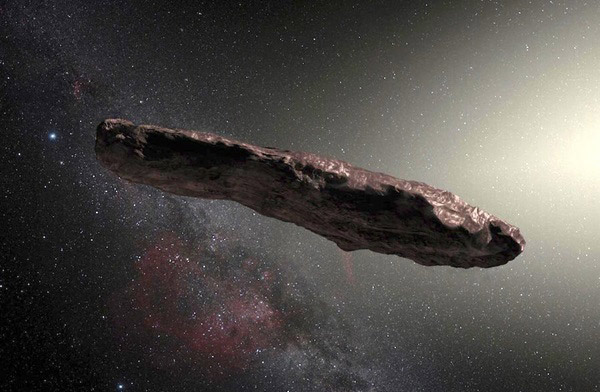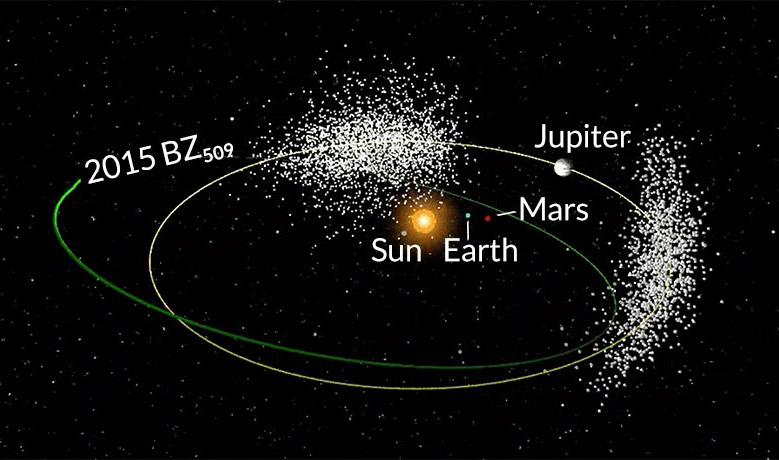interstellar asteroid

Figure 1. Artists's impression of 'Oumuamua.

Figure 2. The orbit of 2015 BZ509, compared with that of Jupiter and the Jupiter Trojans.
Two objects were discovered in 2015 and 2017 which appear to be asteroids that originated outside the Solar System. One, called ʻOumuamua and formally classified as 1I/2017 U1, was first detected when it was about 33 million kilometers from Earth and already heading away from the Sun. The high eccentricity of its trajectory, together with the speed at which it was moving, proved beyond doubt that it was an interstellar traveller that had temporarily wandered into the Solar System and was now heading back toward the stars (Figure 1).
The other object of probable interstellar origin is an asteroid known as 2015 BZ509, which goes around the Sun in an orbit similar to that of Jupiter but in the opposite direction (Figure 2). Computer modeling suggests that it has been in this retrograde orbit for the past 4.5 billion years – since shortly after the planets of the Solar System formed. At that time, all of the material left over from the formation of the Sun would have been orbiting in the same direction. The retrograde motion of 2015 BZ509 implies that it is not indigenous but must instead have come from outside the Solar System and subsequently been captured by the Sun's gravitational field.
ʻOumuamua
ʻOumuamua is an interstellar object that made a closest pass to the Sun of 38.1 million kilometers (0.255 astronomical units) – about 17% closer than Mercury's perihelion distance – on 9 September 2017. It was detected on 19 October 2017, using the PAN-STARRS telescope at Halakala Observatory, Hawaii, and at first suspected of being a comet. Only as its path around the Sun was accurately determined did its true nature become clear. It was found to be on a high-speed hyperbolic path that could only be explained if it had recently come from interstellar space. At the time of its discovery it had already swung around the Sun and was on a departure trajectory from the Solar System.
Observations revealed ʻOumuamua to be highly elongated in shape, measuring about 800 by 100 feet (230 by 35 meters). Based on these unusual dimensions and its extrasolar origin, there was some speculation that the object might be artificial. However, subsequent measurements found no evidence for this. On the contrary, ʻOumuamua appears to be a natural, probably metal-rich (judging by its high density), rock, reddish in color, as in the case of typical Kuiper Belt objects, due to long exposure to cosmic radiation.
It is impossible to say from around which star 'Oumuamua originally came. It arrived from the direction of the constellation Lyra but may have been wandering the Galaxy for tens of millions, if not billions, of years. It may have been ejected from a group of young stars relatively close by, perhaps 40 or 50 million years ago, or it may have been thrown out of a planetary system on the other side of the Galaxy in the much more remote past.
ʻOumuamua isn't unique in being a temporary visitor from the stars. Almost certainly, thousands of such objects pass inside the orbit of Neptune every day before soon heading back into interstellar space. ʻOumuamua just happens to be the first one that we have managed to detect and confirm. In the future, other interstellar interlopers will be found and it may be possible to intercept them before they leave, using high-speed probes, to discover more about their nature and origins.
2015 BZ509
The evidence that 2015 BZ509 came from outside the Solar System is more circumstantial but nevertheless very strong. 2015 BZ509 was discovered on 26 November 2014, using the same instrument, the Pan-STARRS telescope in Hawaii, that found ʻOumuamua. It is co-orbital with Jupiter, which means that it moves around an orbit that is similar to Jupiter's. In fact, 2015 BZ509 takes the same amount of time to orbit the Sun as Jupiter – about 12 Earth years – and is in gravitational resonance with the giant planet. However, as mentioned above, its orbit is retrograde. What's more it appears, from computer simulations, to have been retrograde since the earliest days of the Solar System, shortly after the planets themselves formed. The only reasonable way to explain this backwards motion is if 2015 BZ509 came from interstellar space and was caught by the gravitational pull of the Sun and then maneuvered into its present course by Jupiter's gravity.

